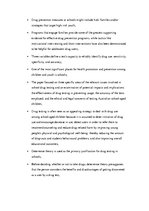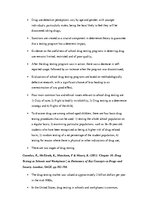-
The Drugs Education Debate: Education, Prevention & Harm Reduction - What Works?
Coomber, R., McElrath, K., Measham, F & Moore, K. (2013) 'Chapter 38: Drug Testing in Schools and Workplaces’, in Dictionary of Key Concepts in Drugs and Society. London: SAGE. pp.182-184.
• The drug-testing market was valued at approximately 2 billion dollars per year in the mid-1980s;
• In the United States, drug testing in schools and workplaces is common;
• Drug tests have limitations in that they cannot identify whether or not a person is addicted to or dependent on drugs;
• Drug testing is offered in the workplace as a method of increasing productivity and ensuring employee safety;
• To date, the consensus is that random drug testing in the workplace, even for safety-sensitive jobs, is not acceptable;
• Outside of the United States, only a few nations have introduced drug testing in schools;
• Only a few researches have looked into the influence of drug testing on schoolchildren's drug use;
• It is hard to determine if changes in students' drug use are connected to the implementation of drug testing in the absence of a controlled experimental design;
• Students' self-reported drug use is typically used in research, and students may under-report drug use if they are worried that admitting their drug use may result in a penalty;
…
Gilman, M. (1993) ‘Smack in the Eye’: ‘Peanut Pete’ and the New Puritans’, International Journal of Drug Policy, 4(1), pp. 28-31. • The creation of the comic book "Smack in the Eye" started and continues to evolve a system that has proven to be exceptionally effective in communicating information to groups of illicit drug users; • stimulant-induced anxiety states and the very real threat of mortality from heatstroke connected with using stimulant drugs in rave situations were all addressed in this campaign; • Creating and sustaining source credibility with drug users' target groups frequently comes at the cost of alienating old and new puritans equally; • Concerns about political correctness concerns like stereotyping result in inertia...




